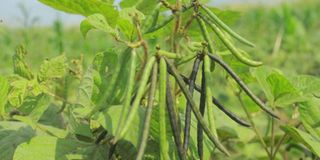Prime
Farmers in eastern, northern Uganda to get new greengram varieties

Greengram in field trials at a research institute. FILE PHOTO
In eastern and northern Uganda, greengram, popularly known as choroko in Ateso, has been cultivated and consumed for a long time in these regions. The area under greengram is expanding due to increased demand, both in local and regional markets especially Kenya and South Sudan.
However, the farmers grow only the local varieties since no improved varieties have been released for commercial production in Uganda.
These local varieties are characterised by low yields (less than 500 kilogrammes per hectare) and long maturity periods of three to four months. They have small seeds, are prone to pod splitting or opening before harvest, and their grains are stony and hard to cook.
Given such characteristics coupled with changing climatic conditions such as erratic rainfall patterns and short rainy seasons, farmers’ returns from greengram are low.
To address these challenges, in 2012, the Dryland Legume Research Programme initiated research to identify varieties that have desirable characteristics and are adaptable to eastern and northern Uganda.
The research programme is based at National Semi Arid Resources Research Institute (NaSARRI) in Serere District. NaSARRI is one of the research institutes under National Agricultural Research Organisation.
So far, the candidate varieties (those earmarked to be submitted for official release) have been identified and will be available to farmers towards the end of 2016. These varieties mature early within 60-70 days, can thrive in short rain seasons, tolerate drought, have large seeds, cook fast, and have higher yields (up to 1,000 kilogrammes per hectare) than the local varieties.
The release of these improved varieties will help boost farm-level productivity as well as farmers’ incomes and thus improve their livelihoods.
Another benefit of the improved choroko varieties is that they can be grown both as single crops (a practice known as mono-cropping) or mixed (intercropped) with other crops such as maize, sorghum since they grow in an erect manner.




